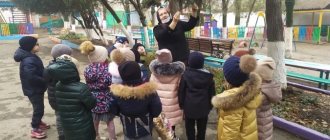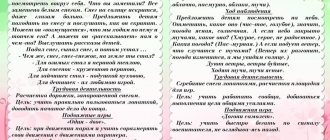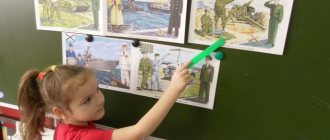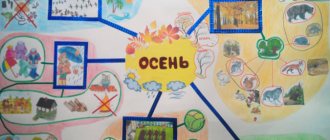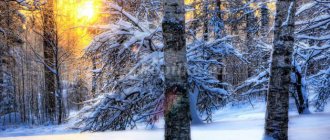Card index of walks. Middle group. WINTER
Target
: deepen children’s knowledge about the phenomena of winter, teach comparisons with other seasons.
Individual work:
Did. game “Winter is good, winter is bad”
Target
: Develop speech, thinking, memory, learn to draw conclusions.
Stand alone games
with external materials, toys, shovels
Walk 8. Observation in the bird park
Goals
: consolidate the idea of the bird world; practice recognizing birds by description.
Progress of observation:
In a free area, place planar images of birds (sparrow, crow, magpie, titmouse, bullfinch) on the branches of trees and bushes.
Before going out for a walk, the teacher announces that today they will go to the park. There are a lot of birds in the park that stay with us for the winter.
Draw children's attention that the birds are not alive, but cut out of cardboard and painted like real ones. Therefore, we do not hear the voices of birds, but you yourself will imitate the voices when you recognize them.
The teacher asks the children riddles.
**I'm sitting on the bitch, Kar-kar! - I shout. (Crow.)
**Chick-chirp! Jump off the branch!
Peck, don't be shy. Who is this? (Sparrow.)
What song does the sparrow sing? Find a flat image of a sparrow on a tree or bush branch and name which tree it was sitting on.
**This predator is talkative, thieving, fussy,
The chirping white-sided bird, and its name is... (magpie).
**Red-breasted, black-winged,
Loves to peck grains
With the first snow on the mountain ash
He will appear again. (Bullfinch.)
Children find these birds after solving riddles. That's how attentive you are: you know all the birds and correctly named the trees and bushes on which they sat.
Labor activity
: Construction of a dining room for birds.
Goals:
learn to help the teacher in placing the feeder, cultivate friendly relationships.
Outdoor game:
"Two frosts."
Goal:
to instill the ability to perform characteristic movements according to the text.
"White Snowflakes" Target:
learn to move smoothly.
Didactic game
"Who lives where?"
Goal
: continue to develop children's knowledge about animals living in the apartment and on the farm.
Individual work:
"Snake" movement.
Goal:
learn to move like a snake one after another.
Stand alone games
with natural material (cones, sticks, leaves, sand)
Walk 9. Observing bird tracks in the snow
Goals:
expand knowledge about wintering birds, find out from the track which bird it belongs to; cultivate observation and attention.
Progress of observation:
We have come to the bird's dining room again. Today we will be trackers: we will determine which of the birds belongs to which tracks. Please note that there are many footprints in the snow: small, medium and large. Who do you think left the smallest footprints in the snow? Of course, they belong to the smallest birds - the sparrow or titmouse. And these are bigger. Who do you think could have left such traces? Well, of course, they belong to the white-sided magpie. And these ones are big. A large bird must have walked here, because the snow fell a little under it. And who do they belong to? That's right, crow. Here, guys, without seeing the birds, you can determine by their tracks who flew into the bird canteen.
Walking in the middle group. February. Card index with goals according to the Federal State Educational Standard. Winter
Card index of winter walks with preschoolers in February. Middle group of preschool educational institutions
Walk #1.
Observation of seasonal changes Objectives: to form ideas about changes in nature; learn to distinguish the characteristic signs of the end of winter (the first drop)
;
consolidate the ability to perceive a poetic description of winter. Progress of observation Poem: Snow and blizzard patterns, In a blizzard field, conversations. Cold, twilight... Day - skates, mountain, sled, Evening - old wives' tales. Here it is - winter! The teacher asks the children riddles . • Walks in the field - but it’s not night. It flies free - but not a bird. (Blizzard, blizzard.)
• He lay and lay, and in the spring he ran into the garden.
(Snow.)
There are
signs: • In February, winter meets spring for the first time. • Pale moon - for snowfall. • If there is a foggy circle around the sun, it means a blizzard. • February - Bokogrey. • February is the end of the cold season, a frosty, bitter and blizzard month, full of surprises and various changes. The first timid drops ring in it, long crystal icicles stretch out, the southern slopes of the snowdrifts become glassy, hiding places appear around lonely trees. February is the month of wolf weddings. In February there are snowdrifts, frequent drifting snow and blizzards, blizzards and blizzards. February is warm on one side and cold on the other. When it thaws, the windows become covered with a layer of water. In frosty weather, this water forms bizarre patterns. The teacher asks the children questions.
• Name all the winter months.
• Why did we cover the tree roots with snow? • Name the signs of February. Labor: Decorating the site with colored pieces of ice - teach how to work in a team; develop aesthetic taste. Outdoor games: “Traps” - learn to run around the entire area, quickly responding to the teacher’s signal. “Don’t stay in the snow” - train children in agility and jumping. Individual work on PHYS: throwing snowballs at a moving target. Individual work: Development of movements - practice sliding;
learn to squat while sliding. Walk No. 2.
Observation of a spruce Purpose: to show children that different circumstances and people can damage or help a living spruce. Progress of observation: Although spruce is a thorny tree, it is also subject to danger. A strong wind can break the trunk, branches, and uproot the tree from the ground. If there is little snow, the spruce and its roots may freeze during the cold winter. A person can damage a spruce tree if he cuts it with a knife or plans to cut it down for the New Year holiday. You can help the spruce tree: dig snow to the trunk to keep it warmer, carefully shake the snow off the branches so they don’t break. Labor: Digging snow to tree trunks to keep food warm in winter - to cultivate a humane and active attitude towards plants, the ability to take care of them in a timely manner. Outdoor games: “Shaggy Dog” - learn to designate objects in different ways in the game. “Mice in the Pantry” - learn to crawl without touching the arc, while developing dexterity and dexterity. Individual PHYS work: sliding down an inclined ice path on two legs. Individual work: “Knock down the pin” - develop dexterity and speed of reaction.
Walk #3.
Observing which birds fly to the site Purpose: to clarify the names of the birds that feed in the feeder and fly near the site; cultivate a caring, caring attitude towards birds. Progress of observation: Please note that not all birds land on the feeder. Look around for other birds that are flying around, watching the feeder and its visitors. Name where the crow makes his observations from (from a fence, roof, tree)
and why they behave this way
(crows are very careful birds, and before going down to the feeder, they will definitely conduct reconnaissance and only then go down to the feeder)
.
How do sparrows behave? Labor: Cleaning the feeder, pouring food into the feeder - teaching how to take care of the birds. Observe the behavior of birds. Some confidently fly to the feeder, others, grabbing the food, fly away with it, others peck under the feeder, collecting only the remains, and others just watch. Didactic game: “Recognizing birds by their tracks” - activating the vocabulary. Outdoor games: “Sparrows” - activation of the sound “h” in onomatopoeia; development of dexterity. “Owl” - teach how to perform movements on a signal. Individual work: Movement development - promote the development of motor skills (running, jumping, throwing snowballs at a target)
.
Independent activities: drawing with sticks in the snow, sledding.
Walk No. 4.
Observing the sun Purpose: to give an idea of the role of the sun in the life of animals and plants; develop observation skills and the ability to make basic generalizations. Progress of observation: Poem: The sun rose before anyone else in the world, and as soon as it rose, it got down to business: It went around the whole earth. And tiredly, the village rested behind the dark forest. If you suddenly find him in the forest, Where there is fog and dampness on the grass, Don’t wake him up: the sun sleeps for minutes, Don’t make noise, it’s been working all day. The sun rises higher, becomes brighter, thawed patches appear on the sunny side; daylight hours are added (the higher the sun, the longer the day)
.
Sayings and proverbs: in winter the sun smiles through tears; The winter sun is like a stepmother: it shines, but does not warm. experiment is to introduce children to the property of sun rays to heat objects. Offer to touch the walls of the house on the sunny side and on the shady side. Ask why the wall is cold in the shade and warm in the sun. Offer to expose your palms to the sun and feel how they warm up. Labor: Sweeping paths with a broom - to teach to carry out work assignments. Outdoor games: “Homeless Hare” - exercise the ability to run without bumping into each other; develop agility and endurance. “Snowflakes”, “Who will reach the flag the fastest?” - develop accuracy, dexterity, speed, ingenuity (complication - include overcoming obstacles)
.
Individual work: Development of movements - practice jumping in place on two legs (20 jumps 2-3 times, alternating with walking)
.
Independent activities: skiing, making snowmen.
Walk No. 5.
Observation of a passenger car Objectives: continue to distinguish cars according to their purpose (passenger cars, trucks)
;
to develop an interest in the driver’s profession, the ability to distinguish between freight and passenger transport. Progress of observation The teacher offers to observe cars moving along the street, examine their appearance, and organizes a conversation. • What types of transport do you know? • What is the difference between a passenger car and a truck and a bus? • What's on the front of the car? (Headlights.)
• What are they for?
(To illuminate the road.)
The car also has fog lights.
They are necessary so that the car can be seen during fog and rain. • Who drives the car? (Driver.)
• Can anyone drive a car?
(No.)
They can be seen everywhere, They can be seen from the windows, They move along the street in a long stream, They transport various loads, And people ride in them.
We loved them for this work. They are called... (cars)
.
Didactic game: “Guess by description” - guess the transport by description. Labor: Shoveling snow into a certain place, cleaning paths on the site, feeding birds - accustom to cleanliness and order; strengthen the ability to work in a team; develop a caring attitude towards animals. Outdoor games: “Owl” - learn to perform movements on a signal. “Don’t stay in the snow” - train children in agility and jumping. “Get into the box” - train your throwing accuracy. Individual work: Walking on the boom; jumping from a place on two legs (energetic push-off and correct landing)
- develop a sense of balance.
Independent activities: playing hockey, playing with buildings on the site.
Walk No. 6.
Observation of icicles Purpose: to consolidate knowledge about the various states of water. Progress of observation The teacher asks the children a riddle and asks them to answer questions. If you sit on the cornice, then they grow down all the time. (Icicles.)
• What does an icicle consist of?
• What properties of ice are you familiar with? An icicle is a frozen droplet of water that has turned into ice. They form only on the sunny side of the house. Why? The snow melts and flows into droplets that do not have time to fall from the roof and freeze. • On a frosty day does the icicle grow or shrink? What about when it’s sunny? • How does a place where there are icicles differ from another area? • Why do icicles grow “head down”? (When a droplet flows down an icicle, it stretches the tip and it becomes thin.)
If icicles appear, this is the first sign that spring is approaching.
Drops - the struggle of spring with winter. Experiment “Snow and ice are water that has changed its state under the influence of temperature.” Goal: to develop observation, the ability to compare, analyze, generalize, establish cause-and-effect relationships and draw conclusions. Break an icicle with your children. Look at it, touch it, tell what it is like. Bring the icicle into a warm room and watch how it melts and what remains of it. Conclusion: under the influence of temperature, the icicle turns into water. Labor: Clearing paths and benches of snow - cultivate a desire to help adults in cleaning the area. Outdoor games: “Hare hunting” - development of dexterity and reaction speed. “Two Frosts” - teach clearly, pronounce the text in the game, follow the rules of the game. Individual work in PHYS: “Obstacle course” - learn to coordinate movements with each other; develop the eye. Individual work: Sledding - learn how to make turns when descending. Independent activities: drawing in the snow, games according to the children's plans.
Walk No. 7.
Observation of pine Purpose: to clarify knowledge about coniferous trees, their similarities and differences (pine, like spruce, is always green, it also has needles, only longer)
.
Progress of observation Poem: Was it a small tree? The pine tree can’t believe it at all: Long ago, from a high cliff, it reached the clouds with its crown, and from the other bank, it reached the shadow of a tree. (V. Mogutin)
People say: “The pine tree is red where it grows,” “Every pine tree makes noise in its own forest.”
Pine is a tall tree, its trunk is straight, its branches are only at the top. The pine bark is rough and rough at the bottom, and thin at the top. Pine has long and narrow needles, which is why pine is called a coniferous tree. The needles are arranged in pairs. Pine reproduces by cones. The teacher asks the children questions:
• What does a pine tree look like?
• Why do they say about pine: “The same color in winter and summer”? Didactic game: “Guess by the voice” - develop the ability to listen to others. Labor: Clearing the area of snow - cultivate hard work and a desire to help others. Outdoor games: “Two Frosts” - teach clearly, pronounce the text in the game, follow the rules of the game. “Snow Carousel” is an exercise in agility, running, and jumping. Individual work on PHYSIO: “Who can turn better” (on skis)
- practice walking on skis with a turn.
Individual work: “Make a figure”, “Hit the hoop” - practice running, the ability to act on a signal. Independent activity: games with external material.
Walk No. 8.
Observing the weather Purpose: to teach to notice changes in nature. Progress of observation Poem: Oh, winter beauty! She whitewashed all the forests, swept up mountains of snow, and invited us to ride. Winter led over us with snow sleeves and scattered snowflakes on the fields and forests. We will ride down the mountain, and that’s why we really, really like winter. The teacher asks the children questions:
What has changed in nature?
What is the earth covered with? What lies on the tree branches? What do trees do in winter? Didactic game: “Name the winter months” - teach children to name the winter months using signs. Labor: Clearing snow from feeders, feeding birds - cultivate a positive attitude towards work. Outdoor games: “Snow Carousel”, “Traps” - learn to act quickly on a signal from the teacher; develop attention and running speed. “Don’t stay in the snow” - train children in agility and jumping. Individual work: “Be the most dexterous!” — continue to develop agility and endurance. Independent activity: playing with snow.
Walk No. 9.
Observing the pedestrian path Purpose: to develop knowledge about the pedestrian part of the road, traffic rules. Progress of observation: Go out with the children to the pedestrian part of the road and ask them where pedestrians are supposed to walk? Remember that you need to stick to the right side, so as not to collide with or go around oncoming people, turning to the side. Remind them that they should walk along the street at a calm pace and cross the road only when the traffic light is green. Bring the children to the crossing, ask how they knew that there was a pedestrian crossing across the road? That's right, because there is a "Pedestrian Crossing" sign and wide white stripes are drawn on the road. Didactic game: “What first, what then?” - develop logical thinking, imagination, continue to teach how to answer in complete sentences. Labor: Clearing the area of snow - cultivate a desire to collectively improve your area. Outdoor games: “Frost - Red Nose” - learn to clearly speak the text in the game, follow the rules of the game. “We are funny guys” - increase physical activity, quickly act on the teacher’s signal. Individual work on PHYS: “Hit the target.” Goal: learn to throw the ball at a target, develop accuracy, follow the rules of the game. Individual work: Development of movements - consolidate the ability to move with an extended step. Independent activities: games with shovels and buckets, skiing.
Walk No. 10.
Observing clouds Purpose: to develop the ability to see the beauty of the sky; develop observation, curiosity, creative imagination. Progress of observation: Riddle: I looked up in the morning - the mountains rose into the sky! These mountains don’t stand, But they fly, fly, fly... (Clouds)
.
Draw the children's attention to the clouds. On a calm, sunny day the clouds move slowly, but on a windy day they move quickly. Compare the color of clouds on sunny and cloudy days. Imagine what the clouds are like. What will the cloud be like if you touch it? Which direction are the clouds moving? Above what object in the area is the cloud that we are observing? (Then it will be clear in which direction from this object it is moving, to the left or to the right. That is where the wind blows.)
Observe not only the direction, but also the strength of the wind.
Sayings and proverbs: February is strong with a blizzard, and March with a drop; February blows away the winter, and March breaks it. Labor: Clearing the area and paths of snow and debris - to cultivate hard work and the desire to complete the work started. Outdoor games: “Two Frosts” - teach clearly, pronounce the text in the game, follow the rules of the game. “Mousetrap” - develop dexterity, the ability to act quickly after a signal. Individual work in physical education: “Funny threes - exercise children in running, turning right and left. Independent activities: skiing, games at the request of children. Individual work: Improving running technique (naturalness, ease, energetic push-off)
- develop coordination of movements.
We recommend watching:
Consultation for parents in kindergarten. Walks in winter Walks in the middle group. December. Card index with goals according to the Federal State Educational Standard. Winter Walks in January in the middle group. Card file with goals for the Federal State Educational Standard Walks in December in the senior group. Card file with goals according to the Federal State Educational Standard
Similar articles:
Winter experiences and experiments for children
Lesson in the middle group “Winter clothes”
Morning exercises in the middle group. December
Thematic days in the senior group in winter
